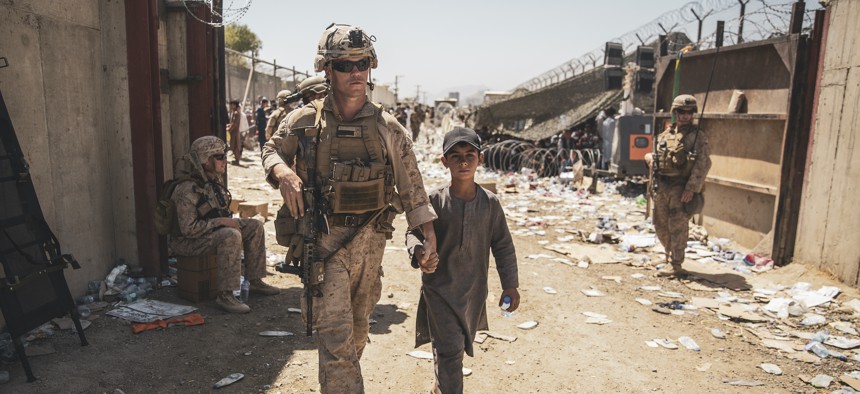
A U.S. Marine with the Special Purpose Marine Air-Ground Task Force-Crisis Response-Central Command escorts a child to his family during an evacuation at Hamid Karzai International Airport, Kabul, Afghanistan, Aug. 24. U.S. Marine Corps / Staff Sgt. Victor Mancilla
Biden Holds to Aug. 31 Evacuation Deadline, But Orders Up ‘Contingency Plans’ for Afghanistan Pullout
Military, contracted planes have airlifted 87,900 people from Kabul as of Wednesday—but the Taliban is now clamping down on who can leave.
Updated: Aug. 25, 9:49 a.m.
President Joe Biden has decided to hold to the Aug. 31 deadline to pull all U.S. troops and military equipment out of Afghanistan, warning the Taliban that the deadline hinges on the group agreeing to let all civilians seeking to depart the country get through the gates.
“The completion by August 31 depends upon the Taliban continuing to cooperate and allow access to the airport for those ... we’re transporting out and no disruptions to our operations,” Biden said in remarks late Tuesday at the White House.
“In addition, I’ve asked the Pentagon and the State Department for contingency plans to adjust the timetable should that become necessary,” the president said.
However, it may not be an option for the U.S. to stay past Aug. 31 because of the deteriorating security situation around the airport. Taliban forces have been securing the area outside the gates and so far, the massive airlift operation has gone off without an attack on the airfield. But that could quickly change if the Taliban loses patience with the withdrawal, or terror groups like Al Qaeda decide to attack on their own.
But getting Afghans out became much more complicated on Tuesday, when the Taliban directed that no more Afghan civilians would be allowed to get to Hamid Karzai International Airport and leave the country, saying their talents were needed to rebuild the country.
White House press secretary Jen Psaki said Tuesday that the president confirmed to other G7 leaders during a virtual meeting that “we are currently on pace to finish by Aug. 31.”
“He also made clear that with each day of operations on the ground, we have added risk to our troops with increasing threats from ISIS-K, and that completion of the mission by August 31st depends on continued coordination with the Taliban,” Psaki said.
In the G7 meeting, Biden addressed the worsening security situation around Hamid Karzai International Airport and the Taliban’s declaration that Aug. 31 is a “red line” for full withdrawal.
National Security Advisor Jake Sullivan has warned that the Islamic State of Iraq and Syria-Khorasan poses an increasing threat around the airport. ISIS-K is a branch of the Islamic State terrorist group active in Afghanistan that U.S. forces have targeted for years.
As of 3 a.m. Aug. 25, U.S. military planes and contracted airlift have evacuated a total of 87,900 people, according to White House numbers released early Wednesday.
The Aug. 31 deadline will mean that in just a few days, at least part of the U.S. forces on the ground will need to switch to pulling equipment out of Afghanistan.
“You need at least several days to get the amount of forces and equipment that we have at the airport, to get that safely and effectively retrograded,” Kirby said.
The retrograde—or full withdrawal—of the U.S. aircraft, weapons, vehicles and about 5,800 troops will make things riskier for U.S. forces. As more troops leave, fewer will remain to protect departing aircraft from crowds desperate to leave, or potential threats of attack from ISIS or al Qaeda.
“You need at least several days to get the amount of forces and equipment that we have at the airport, to get that safely and effectively retrograded,” Kirby said.
The retrograde—or full withdrawal—of the U.S. aircraft, weapons, vehicles and about 5,800 troops will make things riskier for U.S. forces. As more troops leave, fewer will remain to protect departing aircraft from crowds desperate to leave, or potential threats of attack from ISIS or al Qaeda.
That withdrawal will “be done very carefully, and it has to be sequenced in a very methodical way so that the safety and security of our people and the people we're trying to protect is considered of paramount importance,” Kirby said.
That final withdrawal will include airlifting out 500 to 600 Afghan commandos who have been at the airport with U.S. forces helping secure it, Kirby said.
Kirby said the Pentagon would not be providing daily updates on that process to protect troops still on the ground.
A senior administration official said that Afghans evacuated to third-party countries are going through “robust security processing” before coming to the United States.
“That process involves biometric and biographic security screenings conducted by our intelligence, law enforcement and counterterrorism professionals who are working quite literally around the clock to vet all these Afghans before they’re allowed into the United States,” the official said.
The emphasis from the administration counters a view in some parts of the Republican party that Afghan refugees could pose a security threat to America, or that they could enter the country in such large numbers that they could replace natural-born Americans.
“Resettling in America is not about solving a humanitarian crisis, it’s about accomplishing an ideological objective – to change America,” former Trump adviser Stephen Miller told Fox News.
Last week, more than a dozen House Republicans voted against a bill that would speed up the visa process for Afghans fleeing the Taliban.



